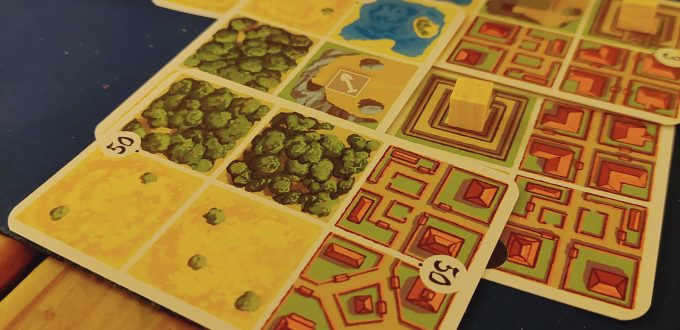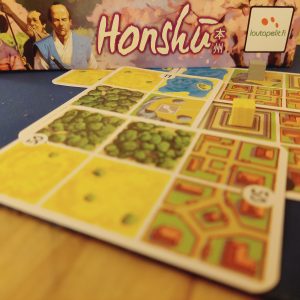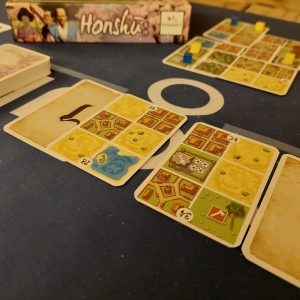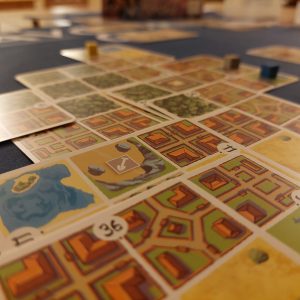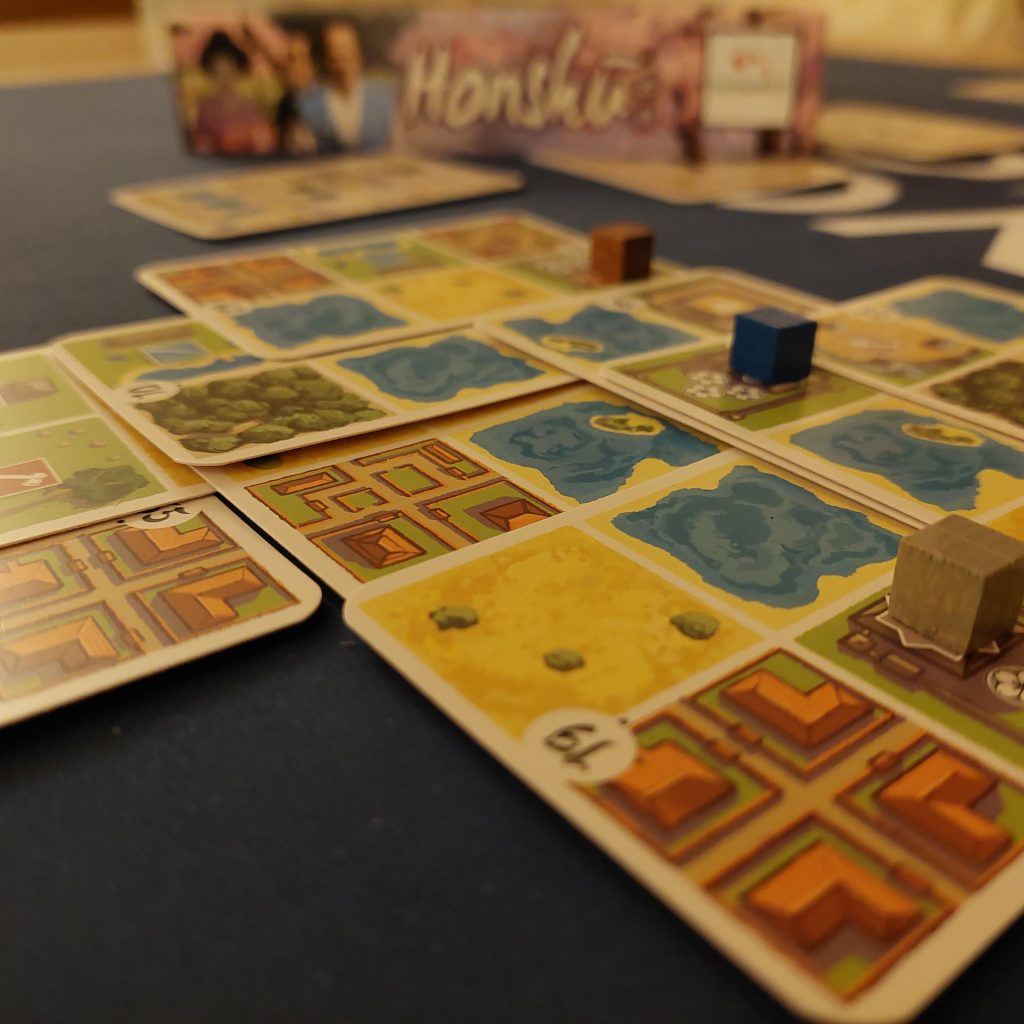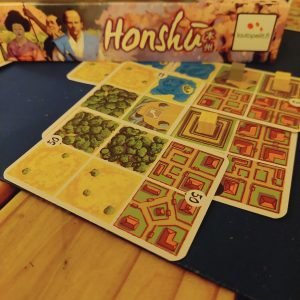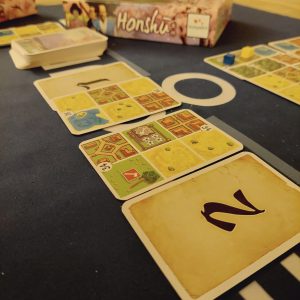Thinky twists on trick taking are going down in feudal Japan in Lautapelit’s Honshũ, and we are going head to head for province perfection!
Publisher: Lautapelit.fi
Designer: Kalle Malmioja
Artist: Ossi Hiekkala, Jere Kasanen
Release date: 2016
2-5 Players
Age: 8+
30 mins
Favouritefoe score 8.5/10
*Auction/Bidding* Strategic * Hand Management * Layering/Patching * Two Player Simultaneous Play * Territory Building * Resource Management * Drafting * Card Game * Trick Taking* Phased Play * Filler
I didn’t realise it until now, but I seem to be drawn to games set in Japan. Hanamikoji, Miyabi, Brains, Kohaku, Seikatsu, Iki……I can’t claim it is down to enjoying a feeling of calm tranquillity – if you have ever played the epically stressful Hanamikoji then you’ll know exactly what I mean!
I also love small box card games. And so, being relatively fresh in the hobby (my 2 year game-iversary coming up in November in fact!), there are still lots of (relatively speaking!) “older games” that are brand new to me. Honshũ is one of them, and boy am I glad I stumbled across this little wonder! I actually have Jamey Stegmaier to thank for it as he posted some photographs of Honshũ on his Instagram account. And being the nosey nellie I am, I went off searching for information about it.
And I was drawn. And I bought. And I played. And I loved it. And now I am going to tell you why!
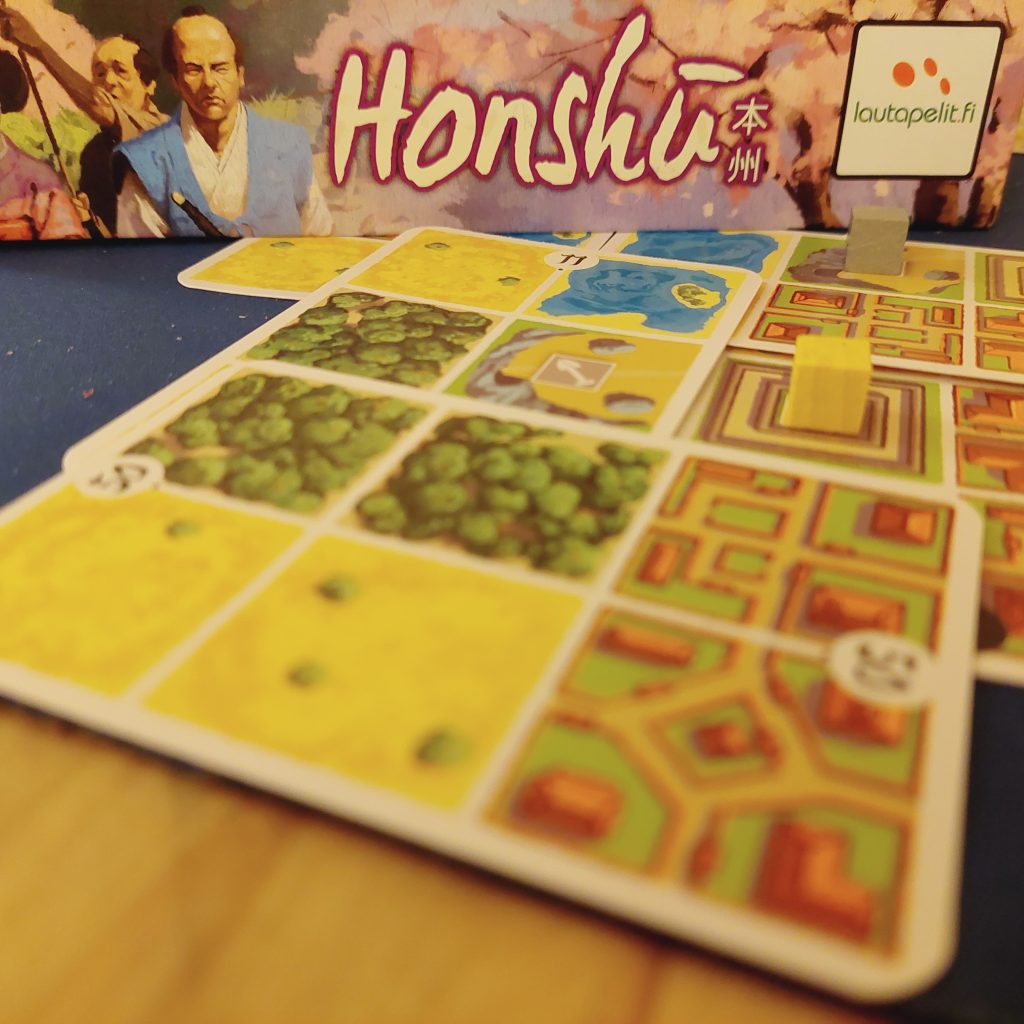
Feudal Fun!
In Honshũ, everyone is playing a Lord or Lady of noble repute, seeking land and productive building opportunities. Towns, lakes, forests, fallow fields, production, factories…..everything you need for a budding medieval metropolis is there. But, over twelve short rounds, you need to build right and balance well if you are going to score big!
Set the Foundations!
Very easy to set up, you start by separating the cards into 60 map cards, 8 scoring objectives, 5 starting province cards, and 5 scoring reference cards. Place the 40 resource cubes (representing fish, gold, wood, and stone) within easy reach and give everybody a random starter and reference card face up in front of them (deciding whether to play the “A” (identical) or “B” (asymmetrical) side of the starter card). Remember to add a relevant resource cube to any empty production square on your starter card.
Shuffle the map cards and deal 6 to each player leaving the deck in easy reach. If you are playing with a scoring objective, choose one at random and place that within sight of everyone. There are also 5 player order cards numbered 1 – 5. These are laid out according to how many players are at the table.
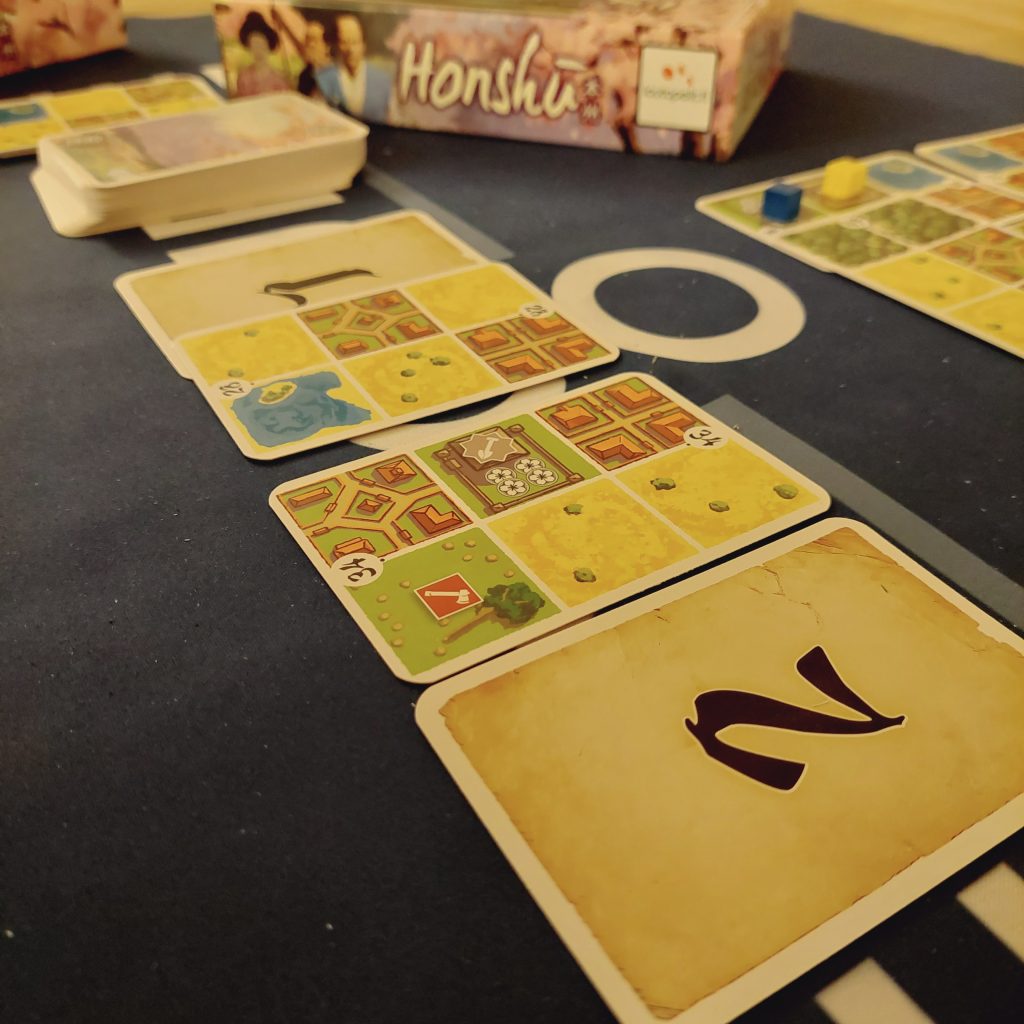
Playing Provinces!
In a 3 – 5 player game, player 1 will begin the trick i.e. round 1 by placing their chosen map card on their player order card for that round. In turn, the other players continue the trick i.e. lay a card until everybody has laid one from their hand. As each map card has a number printed on it, the person who laid the highest number card gets first pick from the laid cards.
However, when laying your card, it is possible to boost the value of it by paying a resource cube already on your territory. One cube is worth 60 so a #13 card played with a cube jumps up to 73.
Other players can also increase the value of the card they intend to play when laying it by adding one or more resource cubes. But those cubes have to be of the same type (i.e. colour) as the one(s) laid by the first person to go boosting (if any).

Layer of the Land!
Once all the cards are taken, the used resources are returned to the pool, and players lay their chosen map card into their own territory. If the new card has any production squares on them, you can add a cube of the matching type onto those squares (but not onto the factories – those come later).
Rounds 2 and 3 continue in the same way. Then, after round 3, all players pass their remaining 3 cards to the player on their left, before resuming the trick and placing phases. At the end of round 6, everybody picks up 6 new cards and play continues. Then after the 9th round, everybody passes their 3 remaining cards to the player on their right. After the 12th round, end of game scoring takes place.
Placing the map cards comes with a few simple restrictions, but they are surprisingly limiting. And, believe me, they trigger trade-offs and balancing exercises greater than their appearance. Particularly when you are thinking about all the different ways to score (more on that later!).
The new card must partially overlap or be tucked under an existing map card by at least one square; and lakes can never be covered up. If you cover up a production square with a cube on it, that cube must be discarded.

Two Player Town!
Because of the trick taking and bidding mechanisms, a two player game of Honshũ works a little differently so as to preserve the tension.
At the start of each round, two map cards are revealed from the map deck and laid face down to forma pair. Then you each simultaneously lay down a card from your own hand to form a second pair.
The player who has laid the highest numbered card gets to decide which pair of cards they want. But before they can take them, the other player gets to decide if they want to pay any 2 (they don’t have to be the same type) resource cubes from their map productions squares to take that pair instead. Once each player has a pair, they choose one to place and the other gets discarded. Any production squares on the new card get filled in the usual way and the rounds continue in the same pattern as the multiplayer version.

Settling The Scores!
Now, I must confess we didn’t score our first game quite right. I don’t really know why as it isn’t tricky. We thought forests had to be adjacent and didn’t realise that cubes couldn’t go straight into the factories. Maybe the rules are a little wordy for what is an easy game to play and score, maybe it was just us trying to play a new game after a long day. Whatever the reason, I’ll summarise it below:-
- Each visible forest square is worth 2 points – forest squares do NOT have to be adjacent to one another to score 2 points;
- Only your LARGEST town zone will score points and town squares MUST be adjacent to count in forming a zone – each square in your town zone is worth 1 point;
- Each lake zone has the potential to score, but the FIRST lake square in any lake zone is worth ZERO. The remainder are worth 3 each. As such, the more adjacent lake squares you can place, the more your lake zone will be worth;
- If you have a factory square in your province of a type that matches a resource cube sitting on a production square elsewhere in your territory can be moved to the factory and will score the points shown on that square – they show 2, 3 or 4 points; and finally
- Points will be awarded for achieving the scoring condition on the objective card (if used).
- Note that fallow fields are worth zero, however, if players are tied for highest score, the player whose province has the most visible fallow fields is the winner.
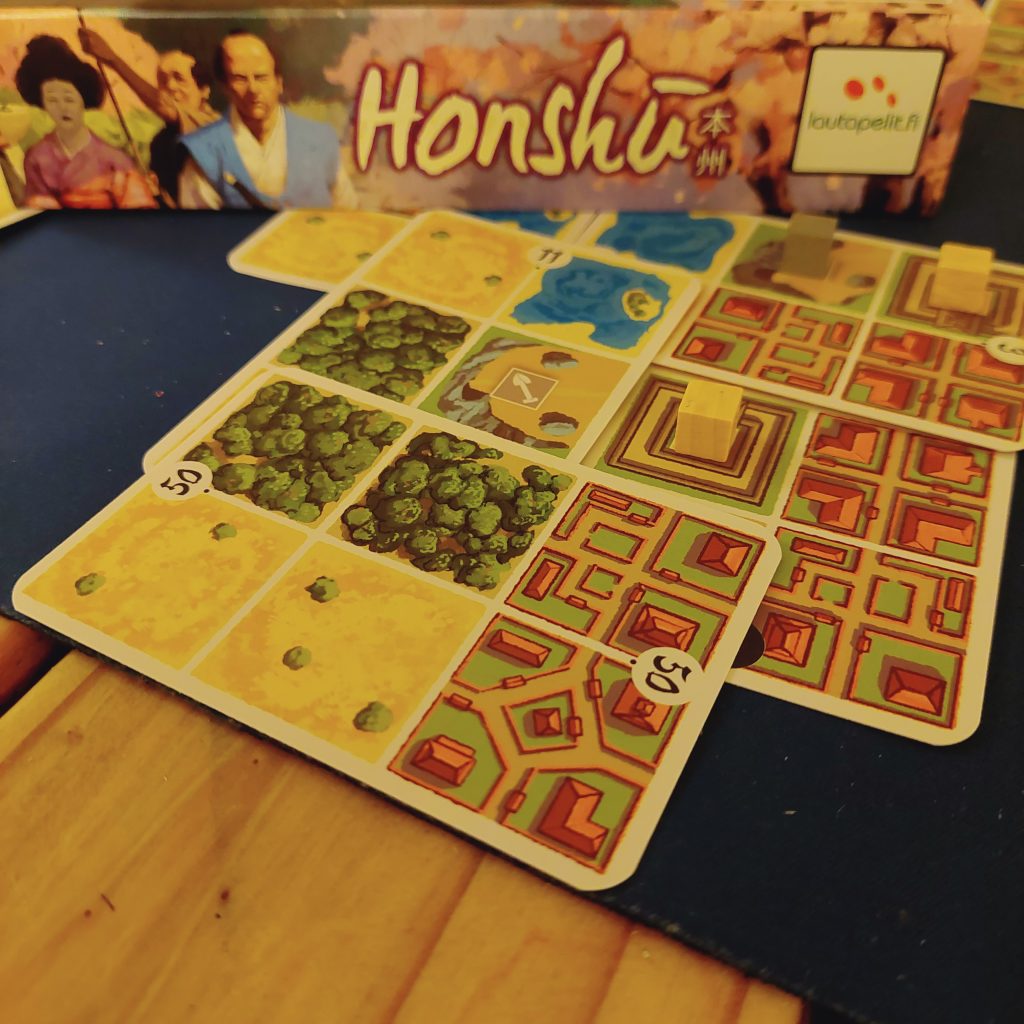
Winner Winner Province Building Dinner!
Like other small box card games we stumbled upon over the past 18 months (Battle Line, Arboretum, Enchanted Plumes), Honshũ has been a crunchy and fast playing surprise. As a result, it has become an instant pre and after dinner gaming hit for us!
ShadowMeepleMedia and I often agree on whether we like something or not by how well it gels with us as a playing pair – a tricksy twosome. Most of our nightly gaming is at two player count (before school, after school, and weekends with the addition of Mini-Meeple), so finding games that really sing to us at two is the sweet spot.
And Honshũ works for us. I won’t lie – being able to hate draft province cards by trumping each other with cubes is a particularly delicious element that we both savour.
I get that there’s no real player order as there is with the multiplayer game. We reveal cards simultaneously each round, so that build-up of tension as cards and the first cube are laid out around the circle isn’t there. But, the element of surprise is alive and kicking. Plus, if you’ve been choosing cards that allow you to build up some cubes on your map, then you’re still able to change things up and mess with a best-laid plan right when things were looking settled. And that is an excellent interpretation of the multiplayer trick tension.
Plus, knowing that your cards are going to be swapped after rounds 3 and 9 focuses the mind on what you want each other to be left with in terms of both numbers and terrain types!
I love how you have to balance laying higher cards against knowing you could lose them. And knowing that after rounds 3 and 9 you lose what you have left to your opponent!
Looking over at your opponent’s map to see what they are going heavy on (including cubes!) helps to form a strategy each round. But also knowing that factories score points at the end gives us pause for thought – do I want to burn cubes now to get that pair, or do I keep it for later or end game scoring? Or is that what they are doing? I never like covering up scoring opportunities, and so layering over full production squares or hiding a new production square under an existing map card is a real AP inducer. But sometimes you have to lose a cube to gain so much more.
I think the only caution I would give is that the glossy cards are prone to slide, so be prepared for your province to shift about as you weave cards under and over existing ones! There’s also no official solo mode (although I have seen a few fan made ones on BGG so I am going to give those a try!).
Honshũ is a great fast playing, thinky little engine building twist on trick taking games that works really well at two player. And it is one that I can’t wait to try with a larger group. I’ve been very impressed by how much Finnish designer, Kalle Malmioja has managed to squeeze into this little game, and also how he has thought about the two-player flow.
I would be really interested to see how it differs from the designer’s reimplementation (Hokkaido), and whether it merits getting both for my Japanese inspired collection! So if any of you lovelies have played both, I’d love to hear from you!

